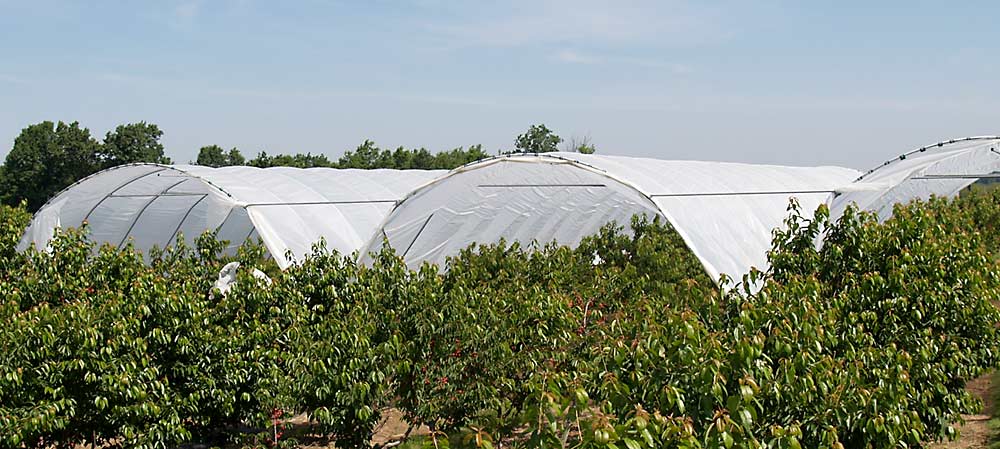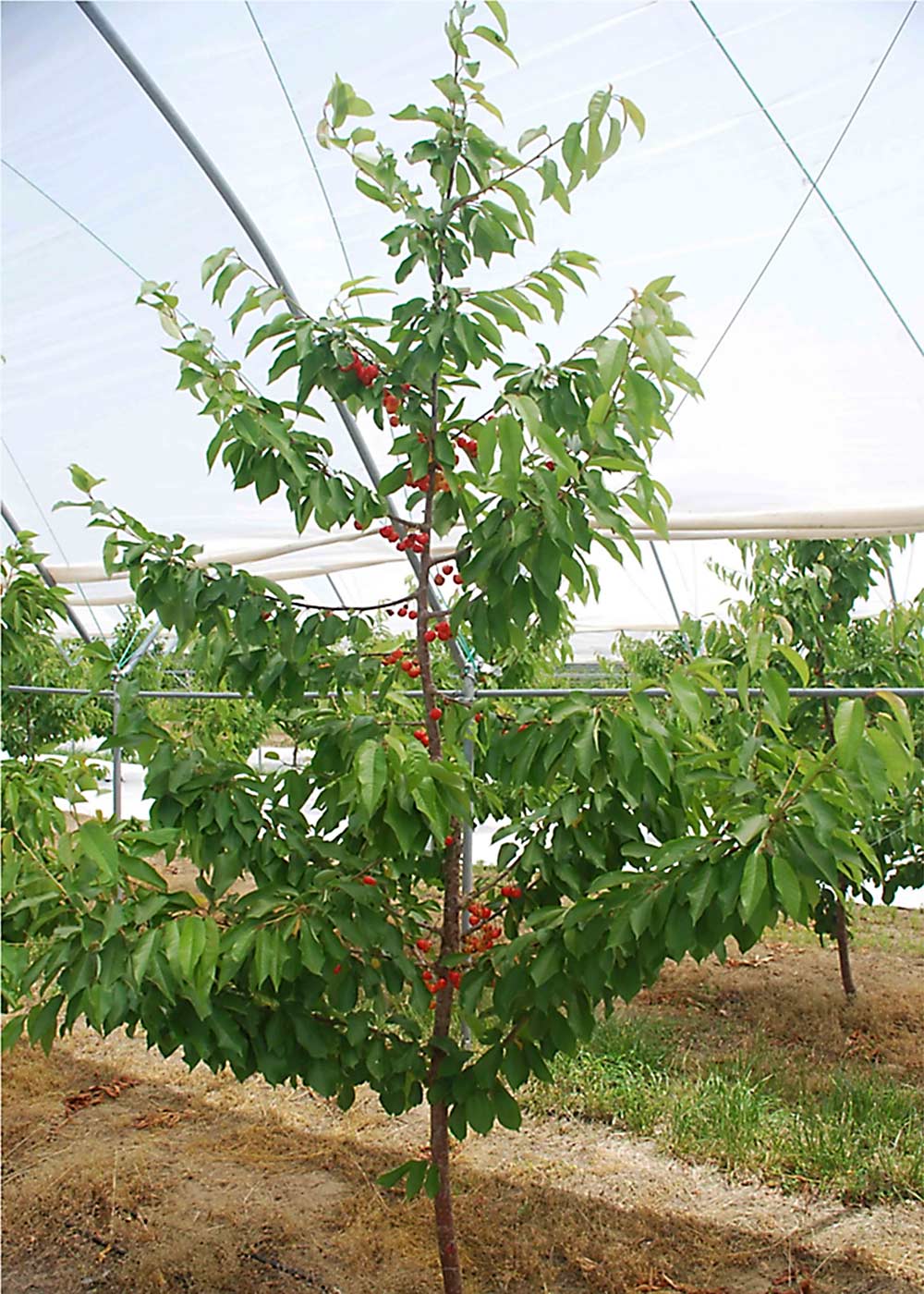
Despite their high up-front cost, high tunnels (shown here) can be a good investment for sweet cherry growers in Michigan and New York, according to a Cornell University study. (Courtesy Greg Lang, Michigan State University)
High tunnels are a great way to get more out of sweet cherries, including larger and earlier-ripening fruit. The question is: Do the potential profits from such premium fruit outweigh the sizable expense of high tunnels? The answer is yes, according to a new Cornell University study of cherries grown in Michigan and New York.
High tunnels are unheated greenhouse structures constructed with plastic tarps.
In the analysis, researchers considered the initial outlay to establish a high tunnel — estimated at $40,000 an acre — plus the roughly $4,000 cost to replace the tunnel plastic every four years and $1,000 in annual labor costs to install and remove the plastic each season.
Despite these costs, the researchers found that high tunnels yielded nearly triple the profits over the life of an orchard when compared to trees grown in the open. In addition, high tunnels even bested crop insurance as a profitability strategy.

Bradley Rickard
Weighing costs and benefits
The study was an outgrowth of a larger project conducted by Cornell and Michigan State University horticultural scientists, who experimented with high tunnels as a way to mitigate some of the common weather-related issues in the East and Midwest, such as late spring frosts that can affect bloom and preharvest rains that can split fruit.
“They were working out the technical aspects of high tunnels, such as when to roll up the sides and how to deal with pests inside the tunnels, but they also wanted to add some economic analysis on the viability of this strategy, so they contacted us,” said Bradley Rickard, the Ruth and William Morgan associate professor in Cornell’s School of Applied Economics and Management. He co-authored the study with three other Cornell economics researchers, including lead author and doctoral candidate Shuay-Tsyr “Nicole” Ho.
Rickard and other economics researchers at Cornell contrasted four strategies sweet cherry growers might take to lessen weather-related risks:
—Growing sweet cherry trees under high tunnels.
—Obtaining crop insurance that provides payments to insured growers when an unavoidable situation, such as a natural disaster or decline in crop prices, causes yield or revenue to fall below a certain defined level.
—Obtaining weather-index-based insurance policies (currently being offered to U.S. growers under pilot programs) that pay out when a specific and measurable adverse weather event, such as a freeze, drought or flooding, occurs.
—Growing cherries traditionally without protection from high tunnels and without crop or weather insurance.

Bradley Rickard was among the Cornell University economics researchers who contrasted high tunnels, crop insurance or weather insurance as ways to provide the best economic return over the life of a sweet cherry orchard. The data showed high tunnels could yield nearly triple the profits when compared to trees grown in the open, and the use of insurance programs could double the expected profits. (Courtesy Greg Lang, Michigan State University)
To analyze the four approaches, the researchers pored through the extensive data the horticultural group had been collecting about production and yields in their experimental high tunnel plots in Michigan and New York. They also considered three to four decades of weather records; historical information about cherry prices, as well as production, yields and costs for traditionally grown cherries; and payout statistics from crop insurance and pilot weather-insurance programs.
“That huge amount of data allowed us to see historical trends and continue those trends forward, so we weren’t just mirroring what happened in the past, but were using the information in the past to help us project the likely paths of costs, prices, yields and weather patterns in the future,” Rickard said.
Using those trends, the researchers developed a computer-simulation to determine which risk-management option was the best bet from an economic standpoint. High tunnels came out on top, showing they could actually triple profits over the course of the orchard’s life, followed by insurance protection.
“There is both experimental evidence and commercial-realized evidence that cherries grown in high tunnels are bigger and can be harvested earlier in the season (than those grown traditionally), and market data show that bigger cherries and earlier-in-the-season cherries are more valuable,” he said. “In addition, because high tunnels pretty much eliminate the cherry-splitting problem, yields are also higher.”
Crop and weather insurance also paid off. “When compared to doing nothing — no insurance and no high tunnels — the model showed that both the crop and weather insurance schemes could double your expected profits over the life of the orchard,” he said.
Insurance might not yield more benefits than costs every single year, but over the 20- to 30-year life of an orchard, it proves to be a good investment, he said.
The only time that doing nothing came out on top was when the researchers tested the unlikely scenario that cherry prices would fall below current or past prices, Rickard said. If price trends continue as expected, however, a risk-management strategy “makes sense financially to a grower,” he said.

A high tunnel in a Michigan orchard provides weather protection for sweet cherry trees. Yield and other data collected from Michigan’s cherry research tunnels were used to help develop a Cornell University simulation model of different risk-management strategies. (Courtesy Greg Lang, Michigan State University)
On to other crops
Although the Cornell research group developed their simulation model specifically for sweet cherries, it could be useful for other crops, according to Rickard.
“Other fruits suffer from different problems than cherries do, but it’s the same idea,” he said. “For instance, we’ve started to adapt the model to look at some related questions about Northeast grapes grown with and without crop insurance to decide whether crop insurance is worth the cost.” He said they may also look at the viability of bird netting as a risk-management tool.
“If you think about it, there are some risk-management options that are more expensive up front, are more expensive year to year, affect prices and costs, and affect yields or the fruit themselves, and we think this model could be a general framework for looking at the economic feasibility of all these options,” he said. •
The full study, titled “Alternative Strategies to Manage Weather Risk in Perennial Fruit Crop Production,” is available at https://doi.org/10.1017/age.2017.29. The research was funded by the National Institute of Food and Agriculture under the Small and Medium-Sized Farms program and Hatch Act.
—by Leslie Mertz






Leave A Comment